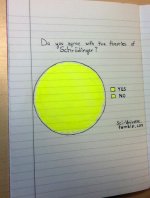Good idea.
The circle represents the current Straightness threshold, i.e. you need to stay inside the circle to get all green.
The score measurement for straightness is proportional to force applied to the butt of the cue by your hand in a radial direction. milli-Newtons isn't an intuitive unit to describe it... so I believe that I previously calculated that a score of 10 on straightness means that you need to apply less force in the radial direction during your forward stroke than the weight of an American quarter (currency), which is 0.2 ounces. That is about 1% of the weight of a standard 19oz cue. The measurement scales linearly, so a score of a 5 on straightness "roughly" means you are applying about 5% of the weight of the cue in force radially.
However, you asked about how this translates to tip offset as a position error. Back of the envelope estimation: Most of the weight of the cue is behind your bridge hand, so lets say (0.2oz x 9.8m/s^2) / (0.9 * 19oz) = 4 in/s^2 of acceleration of the butt. If the bridge hand is 1/3 the length of the cue, and a forward stroke is about 1/10th of a second long, then 1/3 * 4 * (1/10)^2 = +/-13 thousands of an inch (about 1/64th). For a score of 5, the tip would move about +/-1/8th of an inch. Of course, your hand probably applies an impulse of force that requires an integral, so these are only estimates.
